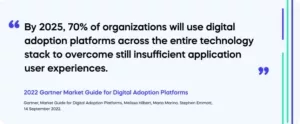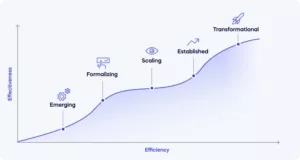The digital age has brought about a wave of change in the way organizations operate, so it’s no surprise that change management is becoming an essential component in this digital transformation journey.
But with this change comes the need for quantifiable progress, and that’s where the Digital Adoption Maturity Model comes in. This model provides a roadmap for organizations to standardize their approach and measure their maturity in the rapidly evolving digital adoption space.
In this blog, we will dive into the different dimensions and outcomes of the Digital Adoption Maturity Model and how it can help organizations achieve a competitive edge.
What is digital maturity?
A digitally mature organization is one that has integrated digital technology into its strategy, operations, and culture to drive innovation, improve customer experience, and create new value.
A company’s digital maturity involves not only the use of technology but also the development of digital skills, culture, and processes that enable the organization to fully realize the benefits of digital transformation.
The benefits of achieving digital maturity
By achieving digital maturity, organizations can unlock new digital growth. Digitally mature organizations are able to consciously design and implement long-term strategies that result in increased profits, enhanced customer experiences, greater operational efficiencies and improved overall satisfaction.
Achieving digital maturity allows businesses to stay competitive in today’s fast-paced market by utilizing the latest transformative technologies such as artificial intelligence (AI), cloud computing, and machine learning (ML). The benefits of digital maturity abound – it creates an agile environment where ideas can be tested quickly, minimized risk while rapidly ensuring growth.
Overall, digital maturity is more than having the latest technology; it’s about embracing innovation while taking advantage of every opportunity to drive meaningful business value through technology investments.
How digital maturity can fit into your digital transformation strategy
Digital maturity is like the foundation of a house. Just as a strong foundation is essential for a sturdy and long-lasting house, a strong digital maturity is critical for a successful digital transformation. It provides a solid baseline to evaluate an organization’s digital capabilities and identify gaps that need to be addressed to achieve digital transformation goals.
A digital maturity assessment can be thought of as a “health check” for an organization’s digital capabilities, helping to identify strengths and weaknesses and prioritize areas for improvement. With this information, organizations can develop a more comprehensive and effective digital transformation strategy that is tailored to their unique needs and capabilities.
In short, incorporating digital maturity assessments into a digital transformation strategy is like building a strong foundation for a house. It sets the stage for success and provides a roadmap for achieving digital transformation goals.
Why do I need to measure maturity?
According to Gartner reports, global IT spend reached $4.4 trillion in 2022 and will grow by 5.5% in 2023. A change management need accompanies every 0.01% of IT spend. Quick math – $464 million dollars of change management needs projected in 2023 alone.
As critical accelerators of change management strategy, digital adoption platforms are becoming an essential enterprise utility – “By 2025, 70% of organizations will use digital adoption platforms across the entire technology stack to overcome still insufficient application user experiences.” (2022 Gartner Market Guide for Digital Adoption Platforms*).
Whether it be as an adjustment to a core offering or a merger/acquisition of new technologies, every organization is embracing a surge in product digitalization. Investing in billions of dollars of change, executives also face the daunting task of a cause/effect relationship to show progress. Today, it’s not enough to embrace an elevated strategy, you have to quantify it.
Where to begin measuring
According to CXO Transform, leaders that measure digital maturity in addition to financial profits, supply chain efficiencies, and customer satisfaction are in the new age definition of a growth mindset.
In 2022, digital adoption platforms were included for the first time in a Forrester New Wave analysis. One of the categories the Forrester New Wave™ evaluates on is Market Approach – “…How does this organization plan to compete better?”
To be innovators and capture market opportunity, executives need to standardize in a category that wasn’t on the map a few years ago. They need to introduce order and objectiveness into an area of subjectivity.
Assess your digital capabilities
Gauging your organization’s ability helps you identify potential weaknesses, measure progress, and make sure you have the right teams and expertise in place to effectively drive digital adoption maturity.
Knowing where your organization is on its digital journey provides valuable insight on what success looks like and how best to get there. It also allows you to adjust quickly as new trends emerge and tailor strategies that work for the business while staying agile in an ever-evolving market.
Digital Maturity Model vs. digital adoption maturity model
The Digital Maturity Model is a framework that assesses an organization’s overall readiness to embrace digital technologies and capabilities, whereas a digital adoption maturity model focuses specifically on how well an organization is adopting and utilizing a particular digital tool or solution.
In other words, the Digital Maturity Model is broader in scope and considers all aspects of an organization’s path to digital transformation, while a digital adoption maturity model is narrower in scope and focuses on the implementation and usage of a specific digital solution.
What is a Digital Adoption Maturity Model?
Maturity models emerged in the last quarter of the 20th century, originally referring to the development and refinement of software engineering processes.
Though the maturity models of today are applicable in a variety of spaces, the common theme is on the growth of a development practice, whether it be software, employee, organizational, or program/operational development.
Following in the path of the first model on record (the Capability Maturity Model from the Software Engineering Institute), many have ~5 stages constituting an evolutionary path of increasingly organized and mature processes.
Popular digital adoption maturity models
A popular model is the Change Management Maturity Model, (from Prosci) measuring depth of organizational competency. The foundation of Prosci’s model moves from ad-hoc to organizationally fluent, which mirrors the trajectory of the Digital Adoption Maturity Model.
Like the Prosci model, the Digital Adoption Maturity Model is a five-level development process. It follows a trajectory of ad-hoc or lack of formalization at lower levels and high integration at higher levels. The following highlights key features of the model and how it builds on its change management predecessor:
How to label the stages of maturity
While the Change Management Maturity Model calls them Levels 1-5, the Digital Adoption Maturity Model has the following names (listed in order of increasing maturity):
- Emerging
- Formalizing
- Scaling
- Established
- Transformational
Defining maturity with language
Akin to the Change Management Maturity Model, lower levels of the Digital Adoption Maturity Model allude to an absent or siloed approach with words like isolated and ad-hoc. As maturity increases, higher levels require the program to be fully integrated in the enterprise infrastructure. Definitions include language such as “Evident in all levels of the organization” and “Embedded in enterprise strategy”.
Executive sponsorship narrative
In higher levels of the Digital Adoption Maturity Model, organizations find increased directional alignment, executive action, and overall reach. This builds off the Change Management Maturity Model by adding industry-specific language (“Company-wide digital adoption mandate”).
Becoming a (digitally mature) category leader
Organizations with both high change management maturity and high digital adoption maturity experience increased market share and optimized profitability. With the highest levels of digital adoption maturity, organizations become increasingly referenceable as a category leader in an emerging category.
To achieve digital maturity, you must demonstrate a more organized and systematic approach to managing people, technology, operations, governance, and innovation.
The next step in your digital transformation journey
It can be daunting to start a digital maturity journey, but it is one of the most important initiatives any organization can undertake in order to secure its long-term success. Therefore, taking those first steps can be critical for companies hoping to thrive in a digital-first world.
Transformational digital adoption maturity is a competitive edge. The Digital Maturity Model is needed not only to commit to cyclical and thorough process optimization within the organization, but also to establish a category of thought leaders within the newly emerging digital adoption space.
If you’re a current WalkMe customer, work with your Customer Success Manager to review your current state, future state, and activities to improve maturity.
Sources
- PR News Wire: Industry Witnesses Tipping Point for Digital Adoption Platforms Like WalkMe as Leading Research Firms Initiate Coverage of the DAP Category
- WalkMe Blog: The DAP Tipping Point: From Category Creation to Market Leadership and Beyond
- A Brief History of ERPs
- CXO Transform
*Gartner, Market Guide for Digital Adoption Platforms, Melissa Hilbert, Maria Marino, Stephen Emmott, 14 September 2022.
Disclaimer
GARTNER is a registered trademark and service mark of Gartner, Inc. and/or is affiliates in the U.S. and internationally and is used herein with permission. All rights reserved. Gartner does not endorse any vendor, product or service depicted in its research publications, and does not advise technology users to select only those vendors with the highest ratings or other designation. Gartner research publications consist of the opinions of Gartner’s research organization and should not be construed as statements of fact. Gartner disclaims all warranties, expressed or implied, with respect to this research, including any warranties of merchantability or fitness for a particular purpose.





